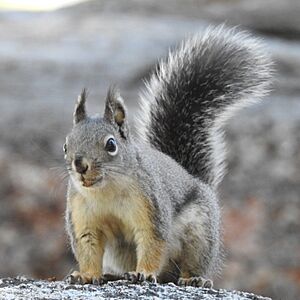Mearns's squirrel facts for kids
Quick facts for kids Mearns's squirrel |
|
|---|---|
 |
|
| Conservation status | |
| Scientific classification |
|
| Kingdom: | Animalia |
| Phylum: | Chordata |
| Class: | Mammalia |
| Order: | Rodentia |
| Family: | Sciuridae |
| Genus: | Tamiasciurus |
| Species: | |
| Subspecies: |
T. d. mearnsi
|
| Trinomial name | |
| Tamiasciurus douglasii mearnsi (Townsend, 1897)
|
|
| Synonyms | |
|
Tamiasciurus mearnsi |
|
The Mearns's squirrel (Tamiasciurus douglasii mearnsi) is a special type of squirrel. It is a subspecies of the Douglas squirrel. This squirrel lives only in Mexico. It is an endangered animal. This means there are not many of them left.
Mearns's squirrels are in danger because they are losing their homes. They might also face competition from other squirrels. The eastern gray squirrel was brought to their area in 1946. We don't know much about Mearns's squirrel behavior. Scientists first studied them closely in 2004. The squirrel is named after Edgar Mearns. He was a naturalist from the 1800s.
Contents
What is Mearns's Squirrel?
Scientists once thought the Mearns's squirrel was its own species. This was because it lived in a very isolated place. But new studies show it is very similar to the Douglas squirrel. So, it is now called a subspecies of the Douglas squirrel.
Even though it's a subspecies, it acts differently. It also lives in different places than other squirrels like it. This makes the Mearns's squirrel very important to protect.
How to Spot a Mearns's Squirrel
Mearns's squirrels are small tree squirrels. Their head and body are about 20 centimeters (8 inches) long. They weigh around 270 grams (9.5 ounces). That's about as much as a can of soda!
They have soft, thick fur. Their upper body is grey-brown. Their belly is white with yellow spots. A solid black stripe runs along each side. A narrow reddish-yellow band goes down their back. Their tail is bushy and darker than their body. It has white and yellow edges. Their head is mostly grey. It becomes yellowish near their nose. They have dark ears and clear white rings around their eyes.
Where Mearns's Squirrels Live
Mearns's squirrels are found in only three spots. These places are in the Sierra de San Pedro Mártir. This mountain range is in Baja California, Mexico. The area around them is mostly desert and dry land. This keeps them separated from other squirrels.
Scientists think they are a relict population. This means they were cut off from other forests long ago. This happened during the Pleistocene Ice Age. The three places they live are pine and fir forests. They are high up, between 2,100 and 2,400 meters (6,900-7,900 feet) high. Their total home area is small, about 40,655 hectares (157 square miles).
Daily Life and Behavior
Mearns's squirrels are active during the day. This means they are diurnal. They are also herbivorous. This means they eat plants. They mostly eat seeds from fir and pine trees.
Unlike their relatives, like the Douglas squirrel, they do not hide food. They don't store it for later. They rest inside holes in trees. They do not build nests from leaves. These squirrels do not seem to be territorial. Sometimes, two squirrels might even share the same resting hole.
They make different sounds. These include a high-pitched "rattle." They also make chirping and barking sounds.
Reproduction and Life Cycle
Mearns's squirrels usually mate from February to August. A mother squirrel can have one or two litters each year. Each litter has about two to five young squirrels.


